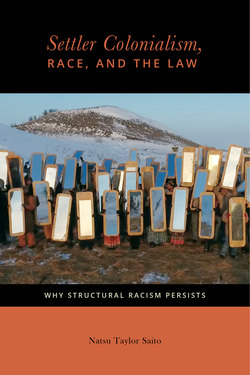Читать книгу Settler Colonialism, Race, and the Law - Natsu Taylor Saito - Страница 32
На сайте Литреса книга снята с продажи.
Racialization
Оглавление“The organizing power of the idea of the Indian as incommensurable savage inspired a new art of imperial government administered by the West’s first modern settler-state society. . . . [and] was the inaugural step in defining a white racial identity for the United States as a nation,” according to Robert A. Williams Jr.7 By racially constructing Indigenous peoples as part of that wilderness, as “beasts” rather than as fellow human beings, the colonizers could justify virtually any atrocity they perpetrated. Veracini describes this as “perception transfer,” an assertion that Indigenous peoples do not really exist, except as part of the natural landscape.8
Thus, the United States’ Indian policy began with George Washington’s proclamation that “the gradual extension of our settlements will as certainly cause the savage, as the wolf, to retire; both being beasts of prey, tho’ they differ in shape.”9 The relegation of American Indians to nature—and, therefore, in the settlers’ view, outside the bounds of human society—is embedded in law, as well. The Supreme Court’s defense of settler property rights rests, to this day, on the premise that Indigenous peoples were “wandering hordes” and “fierce savages,” that “to leave them in possession of their country, was to leave the country a wilderness.”10
Such depictions reflect a colonial strategy of conceptual displacement that allows Indigenous peoples to be excluded from “civilized” spaces. But the narrative of American Indians as “pathologically mobile and ‘nomadic’”11 goes beyond facilitating their exclusion from territory claimed by the colonizing power. It also means that “when really existing indigenous people enter the field of settler perception, they are deemed to have entered the settler space and can therefore be considered exogenous.”12 In other words, American Indians become a threat to society simply by virtue of existing. The settlers deny that “wandering savages” come from any given area; therefore, they have no cognizable rights anywhere. This is why it took twenty years of contestation for US scientists and judges to concede that the Native peoples of the Columbia River Valley were entitled to bury the remains of their Ancient One (“Kennewick Man”) who died some nine thousand years ago in the Pacific Northwest, in accordance with the Native American Graves Protection and Repatriation Act.13
The tropes of American Indians as not only uncivilized but part of the “wilderness” continue to pervade popular consciousness. Into the early 2000s, natural history museums across the country routinely displayed “American Indian cultures alongside dinosaur fossils, gemstones, and taxidermied animals.”14 In 2016 presidential candidate Hillary Clinton analogized her opponent Donald Trump to men who “get off the reservation in the way they behave and how they speak,” to which Trump gloated, “the Indians have gone wild” over her use of the phrase.15 Contemporary examples abound, but one need look no further than the settlers’ furious insistence on a “right” to preserve the name and imagery of the Washington, DC, “Redskins” football team—despite well-documented association of the term with scalp bounties—to appreciate American society’s profound cultural attachment to the image of Indian-as-savage.16
The dominant narrative attempts to transform hundreds of sovereign nations into “a race,” and then to racialize Indigenous people as inherently backward or—at best—ecologically conscious holdovers from a bygone era. The focus on “race” facilitates the incorporation of Indigenous peoples into a minority rights framework that presumes the legitimacy of the settler state and undermines their right to self-determination. Thus, the Trump administration’s 2018 call for a racial definition of American Indian identity was intended not only to subject Indians to the work requirements of the new healthcare law, but to undermine their political status as well.17 More generally, the racialization of Indigenous peoples as other than human, as uncivilized and always a potential threat, has facilitated the colonizers’ many attempts to “disappear” those whose very existence calls the legitimacy of settler sovereignty into question.
